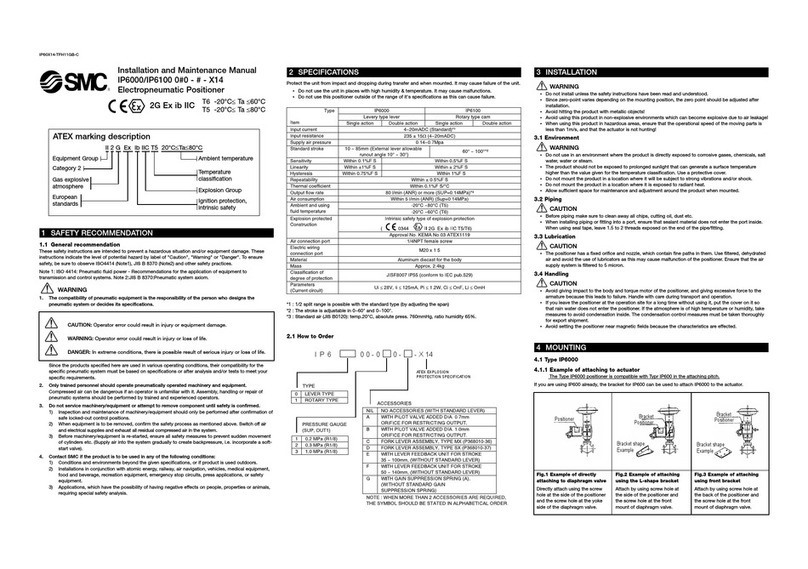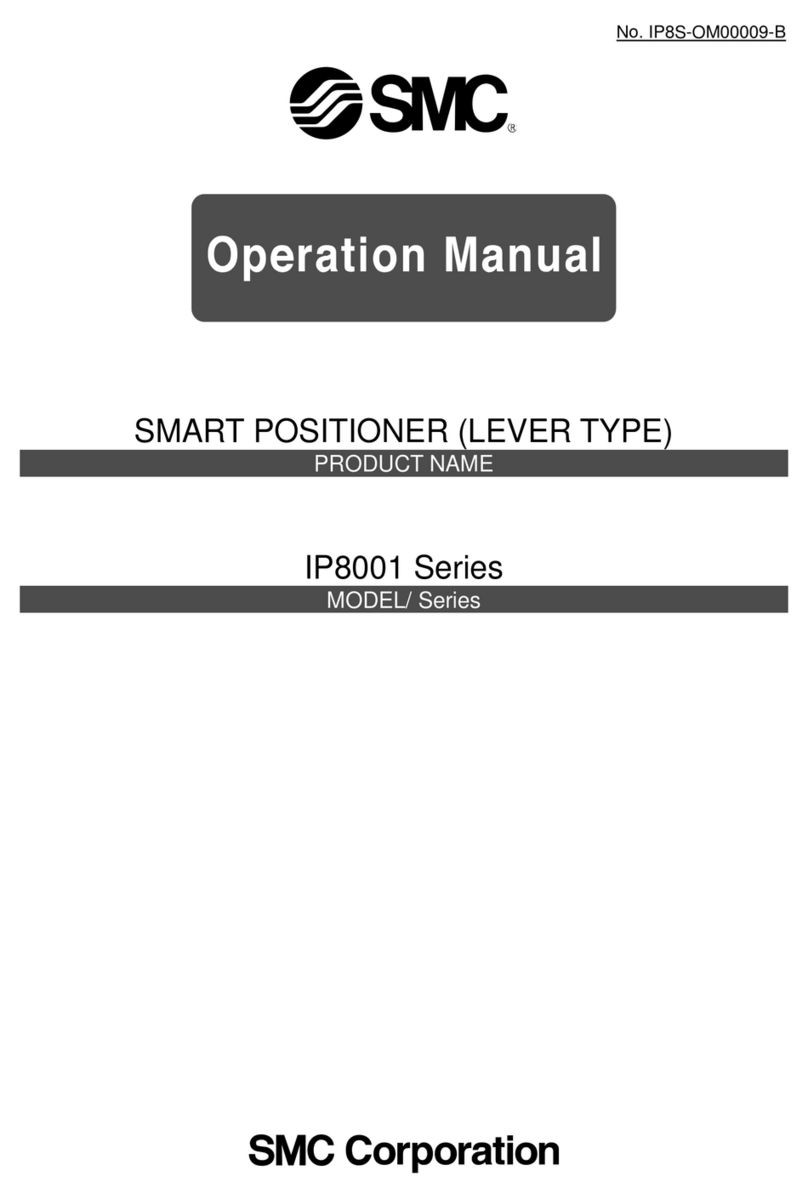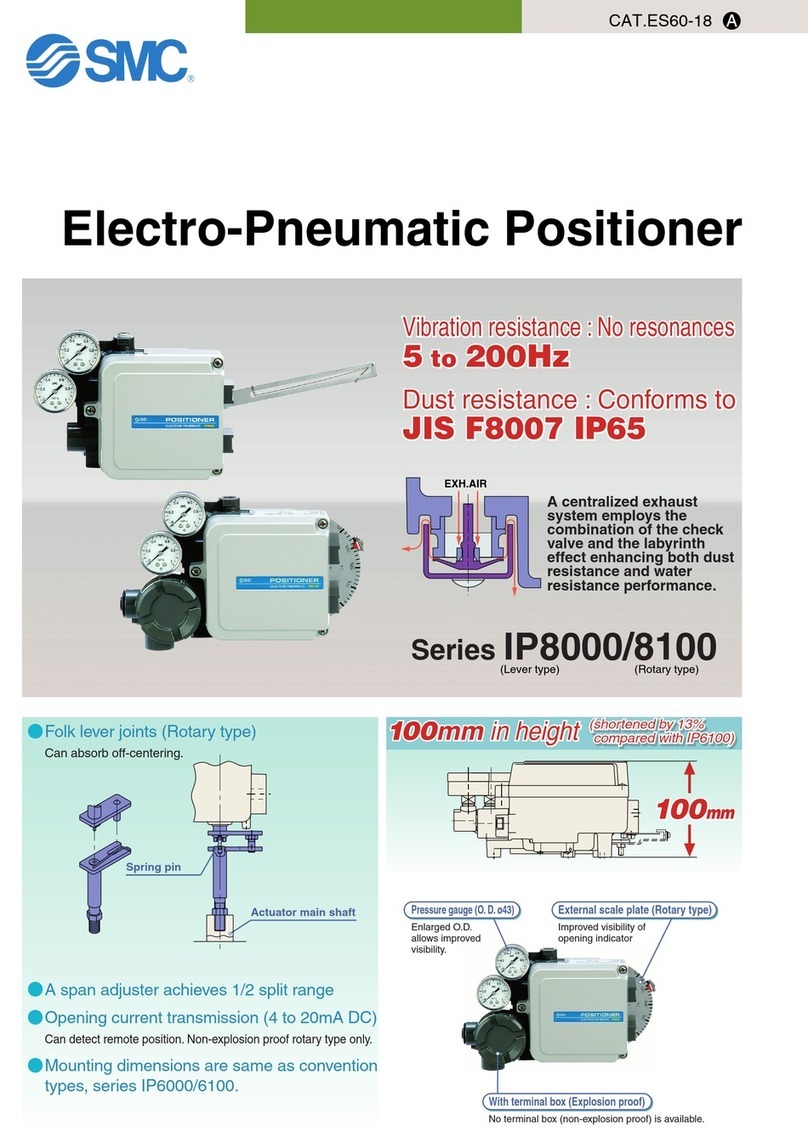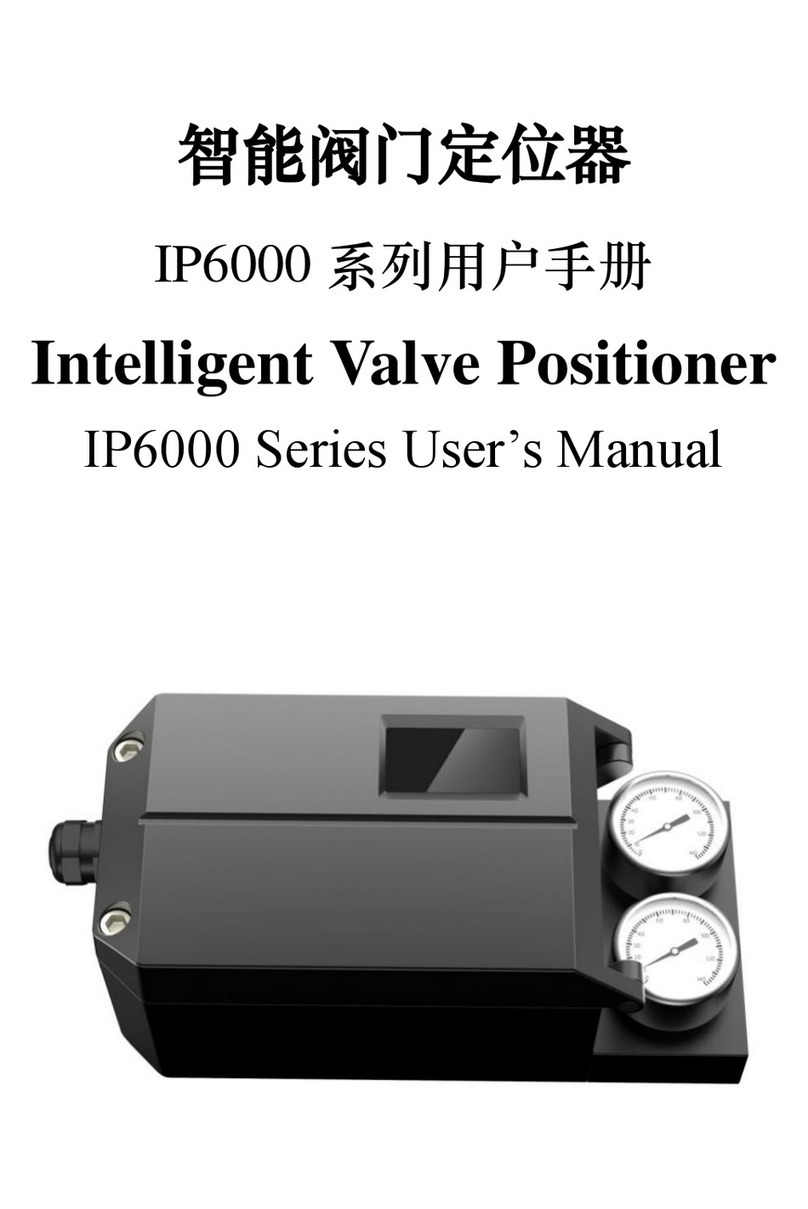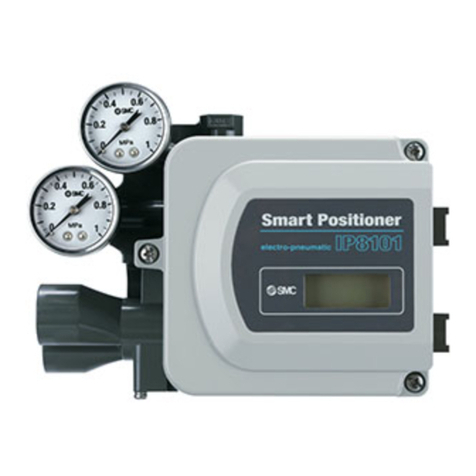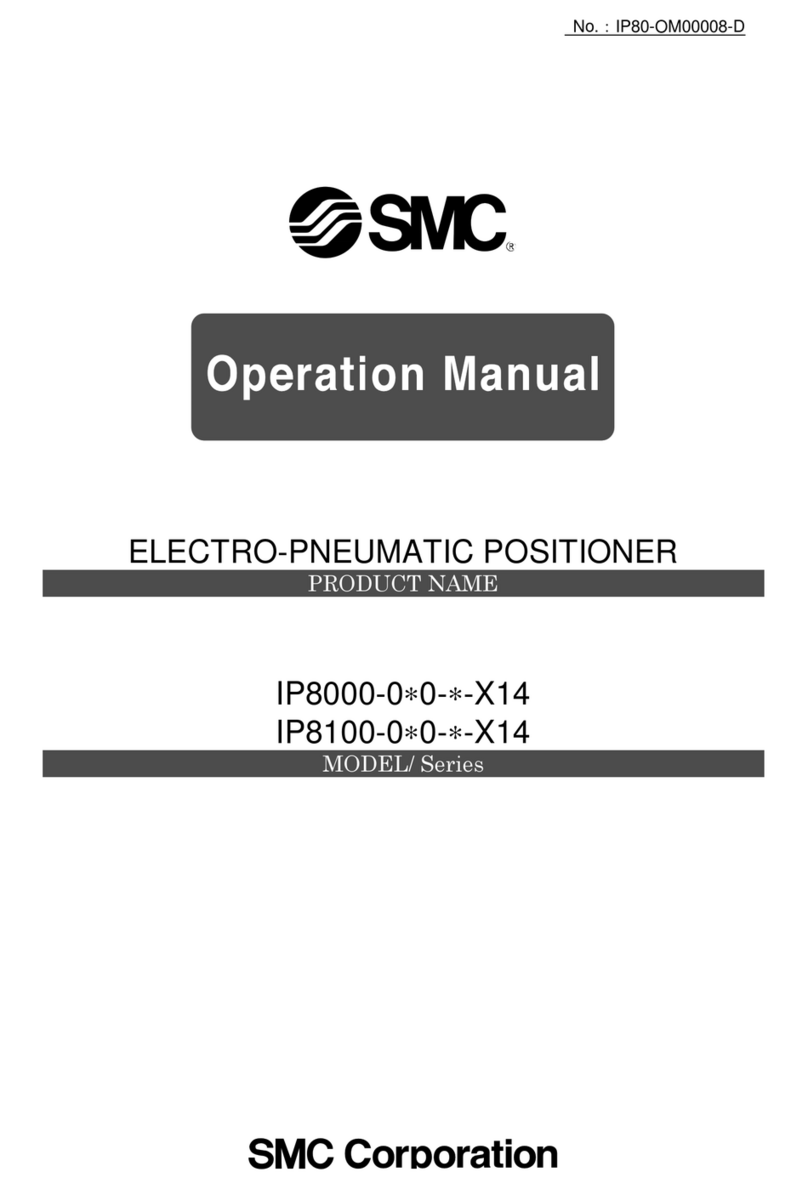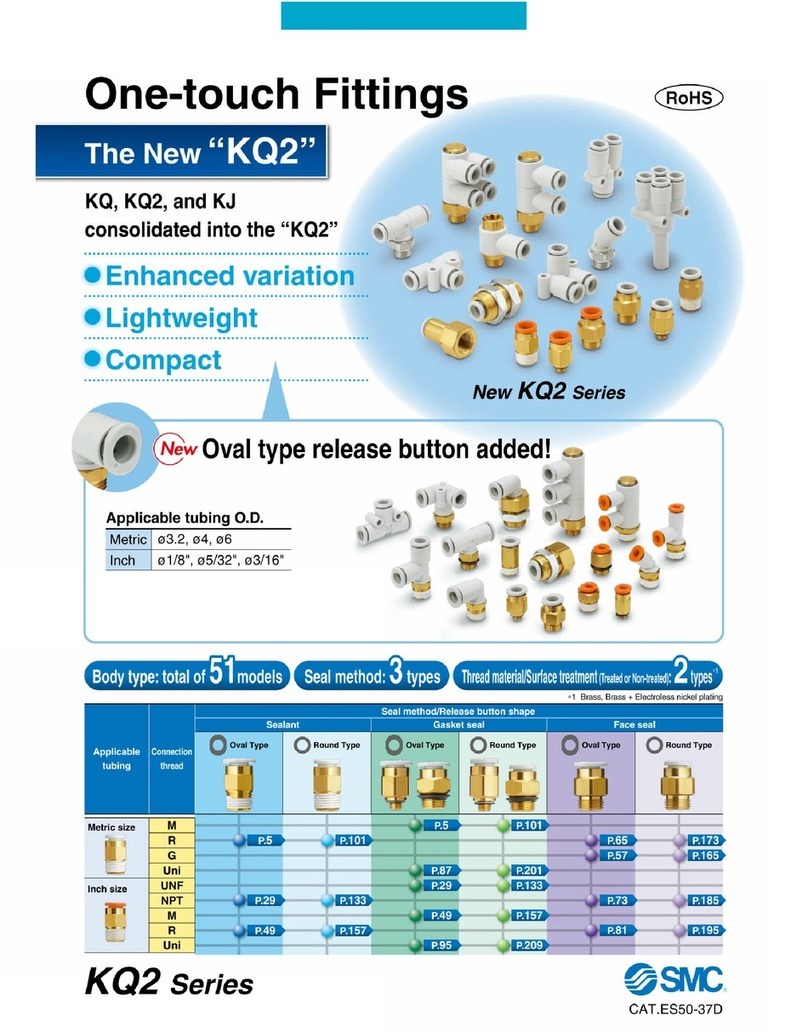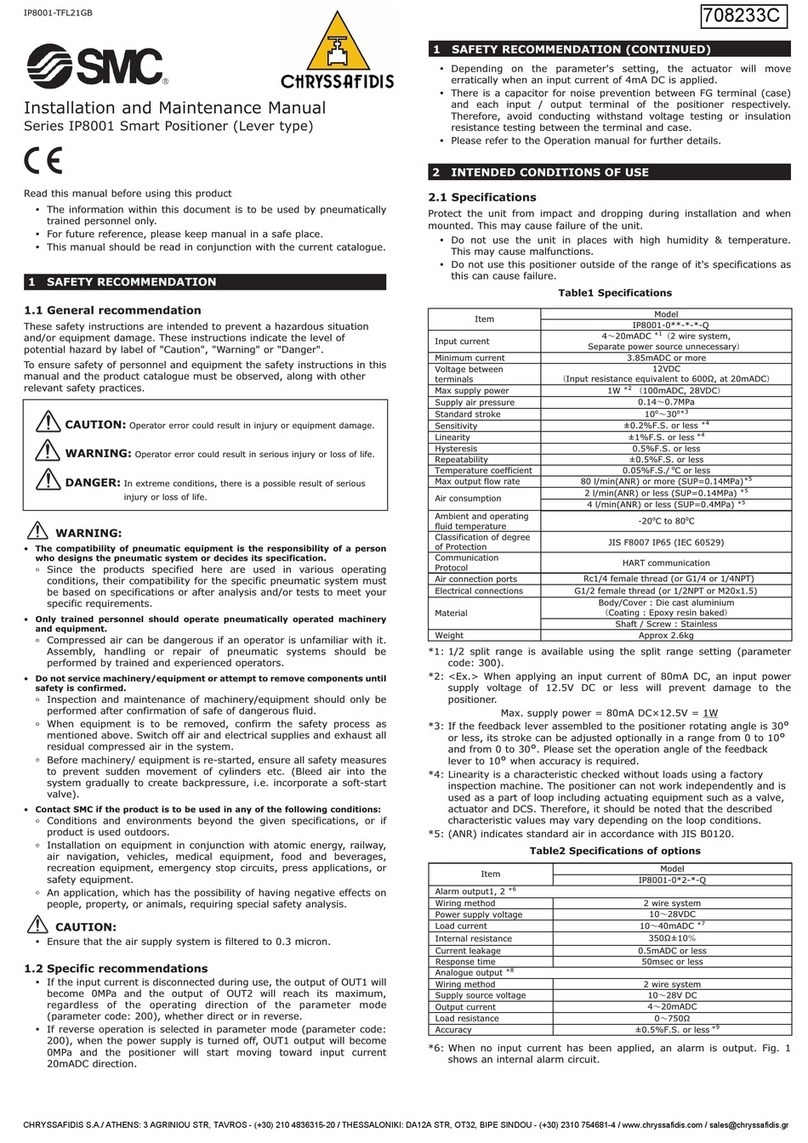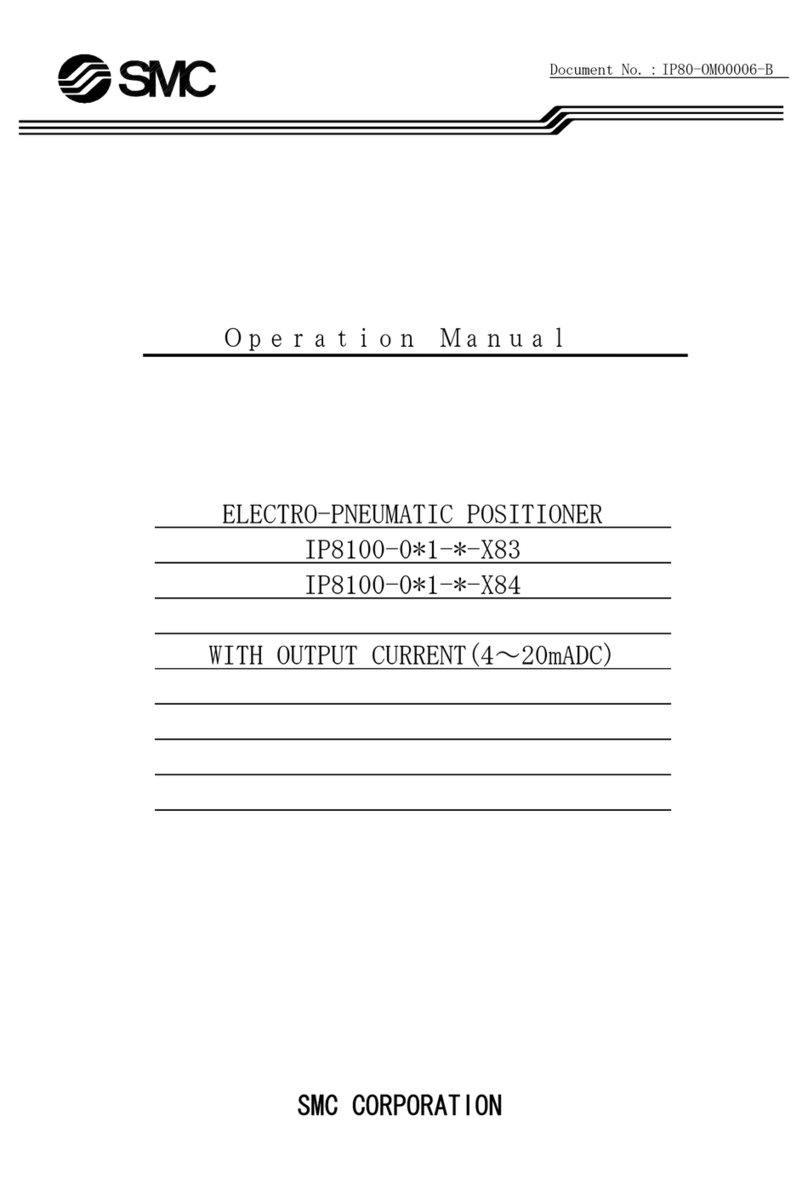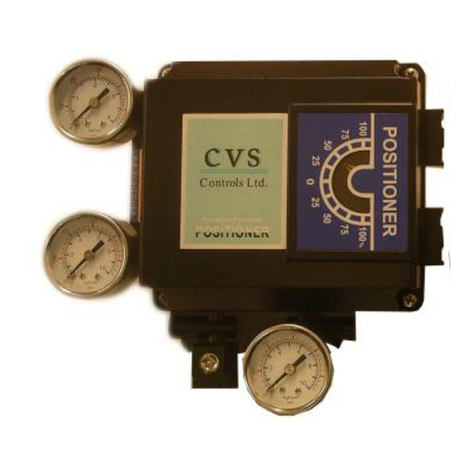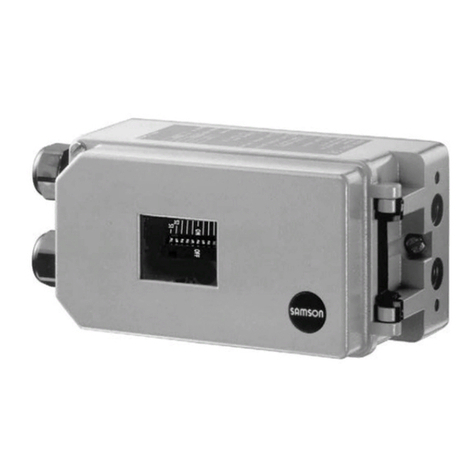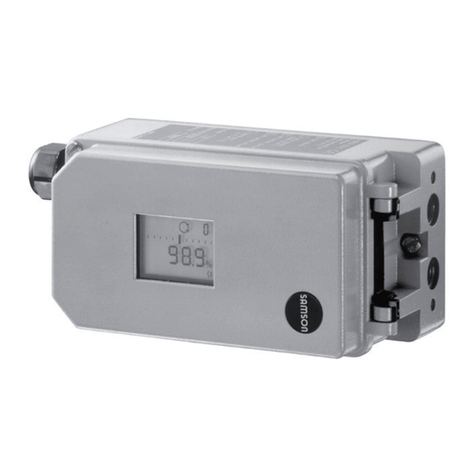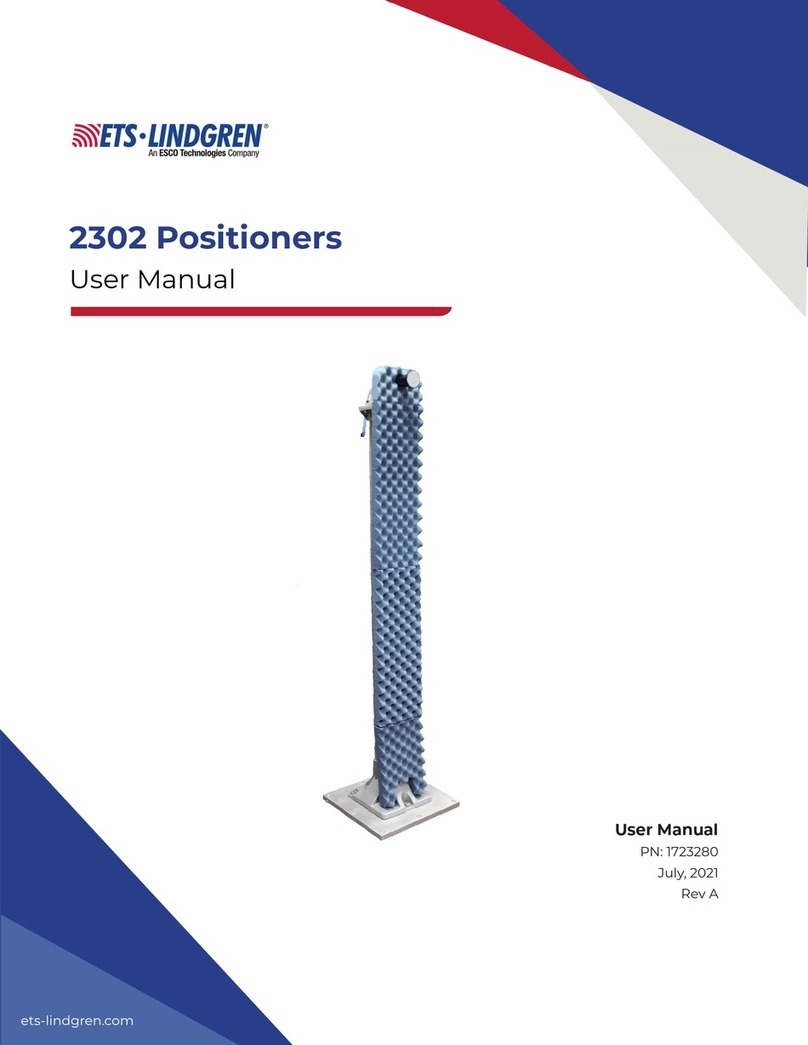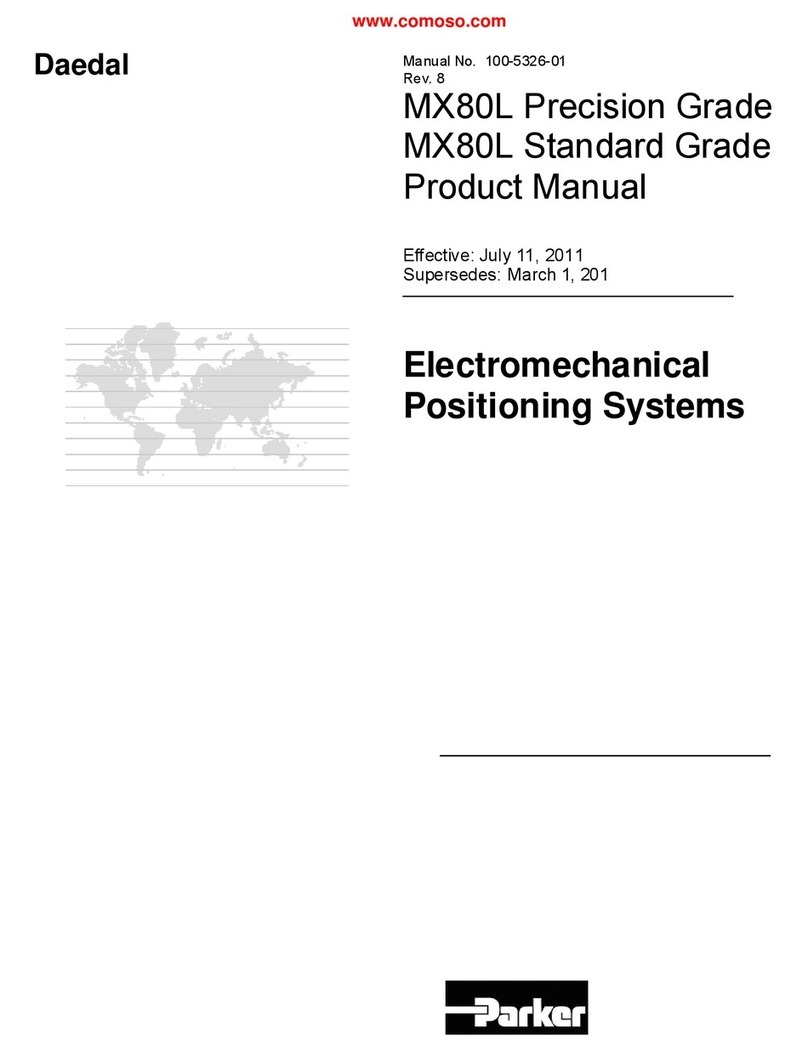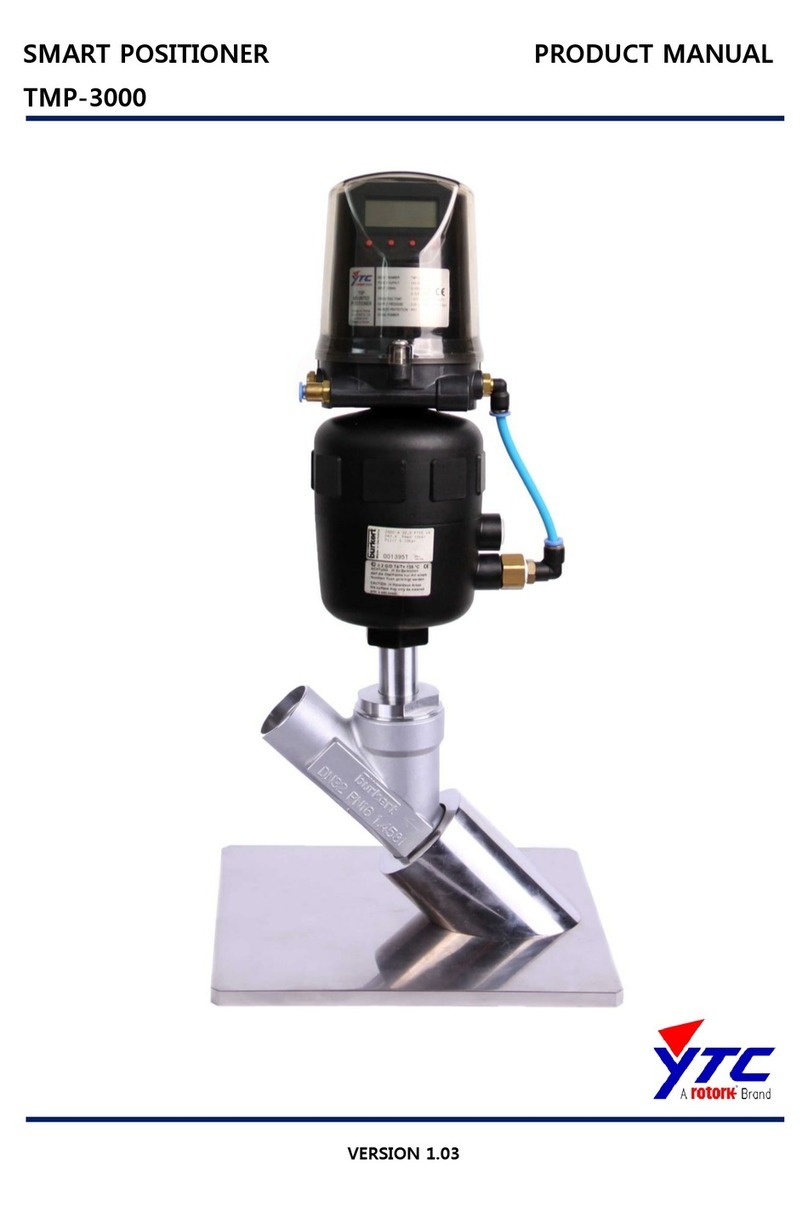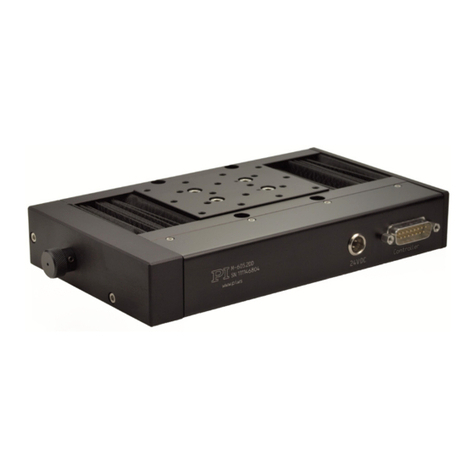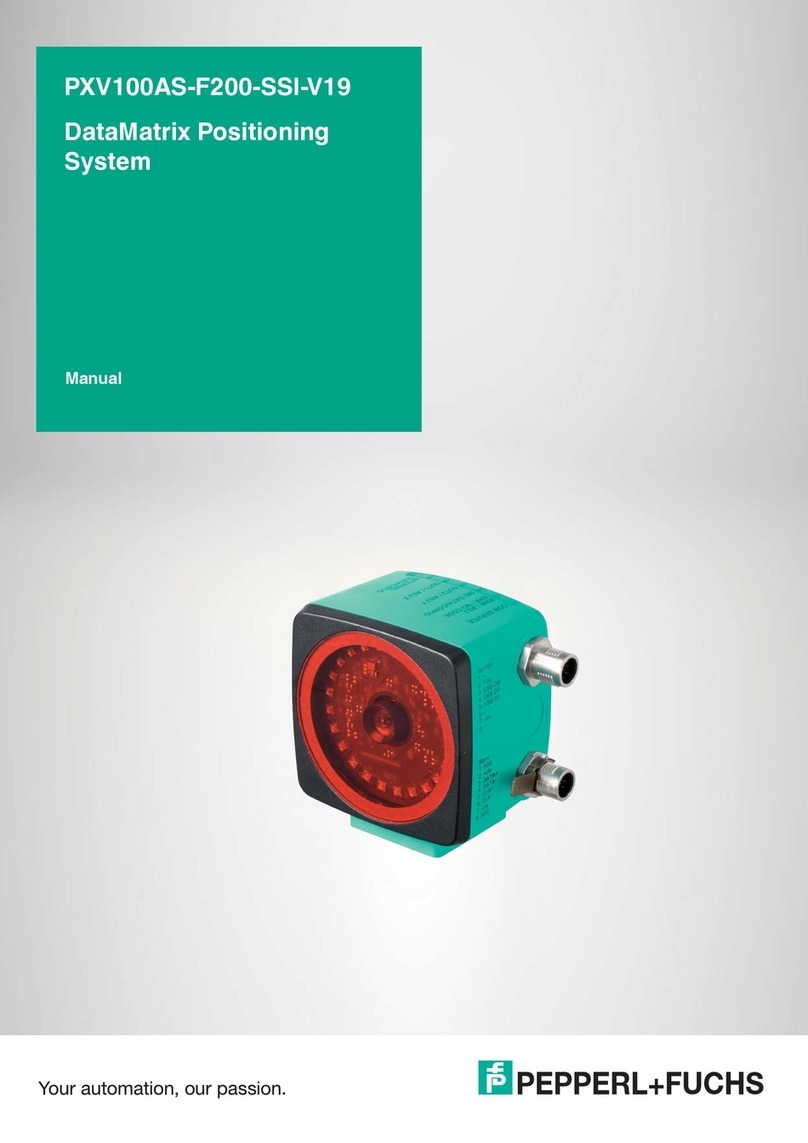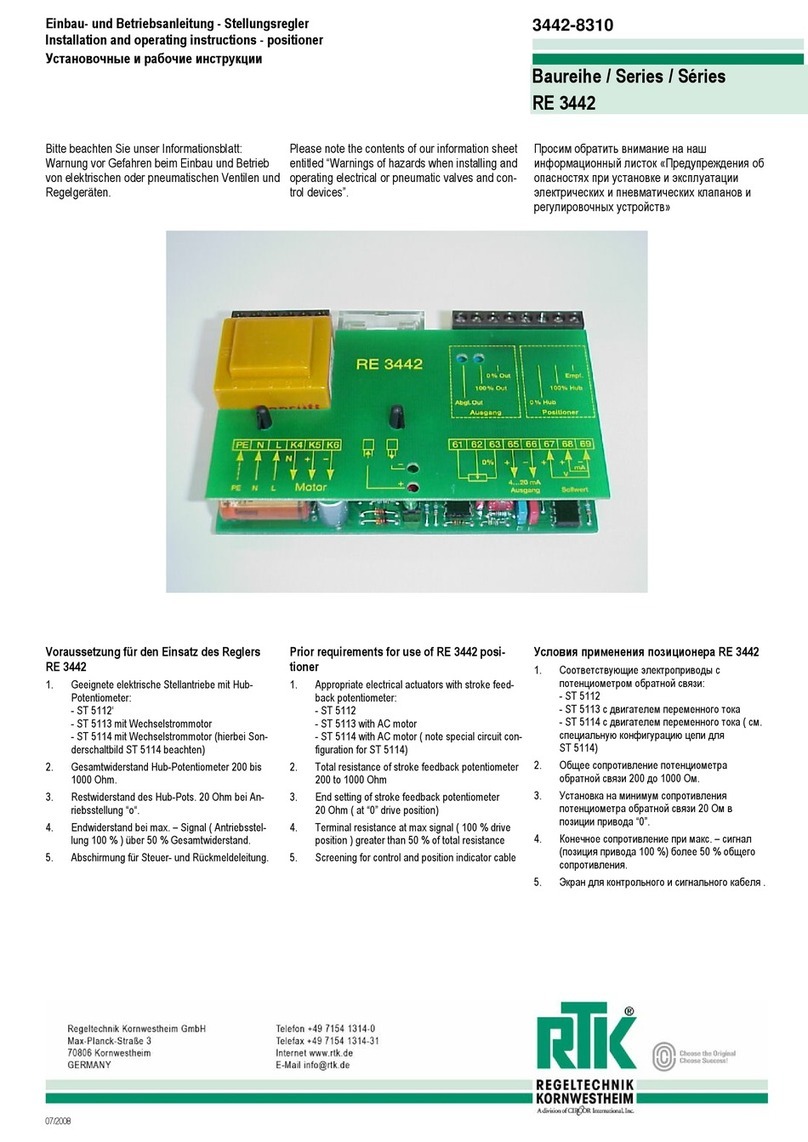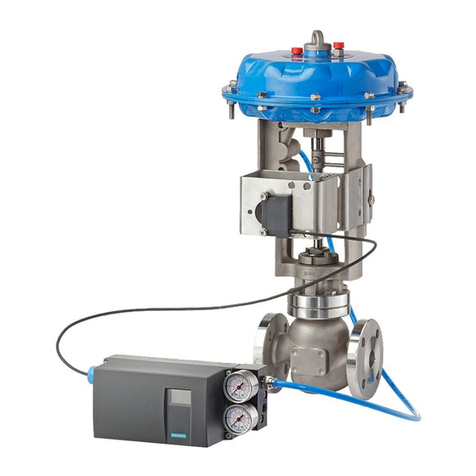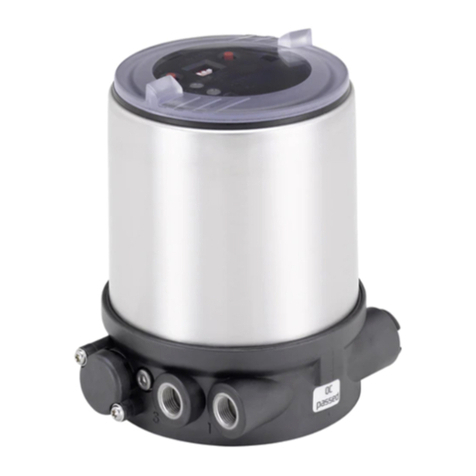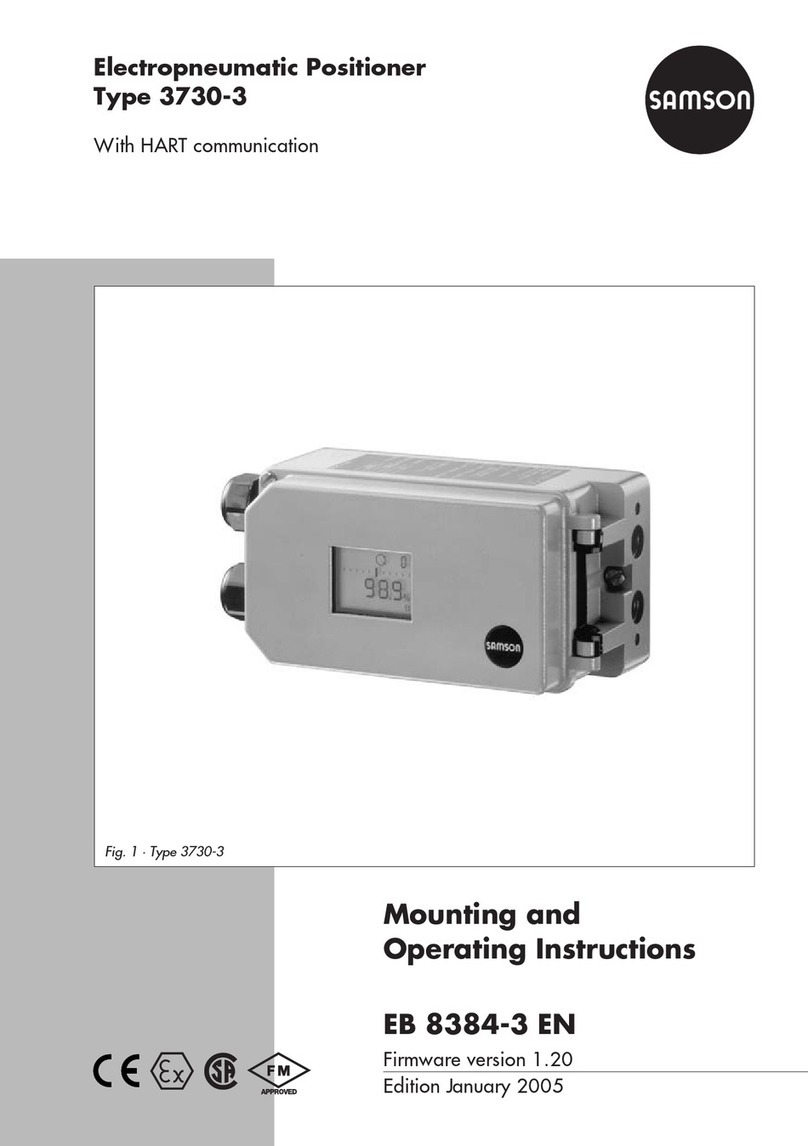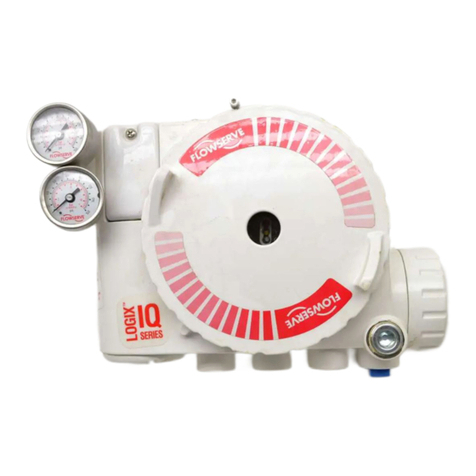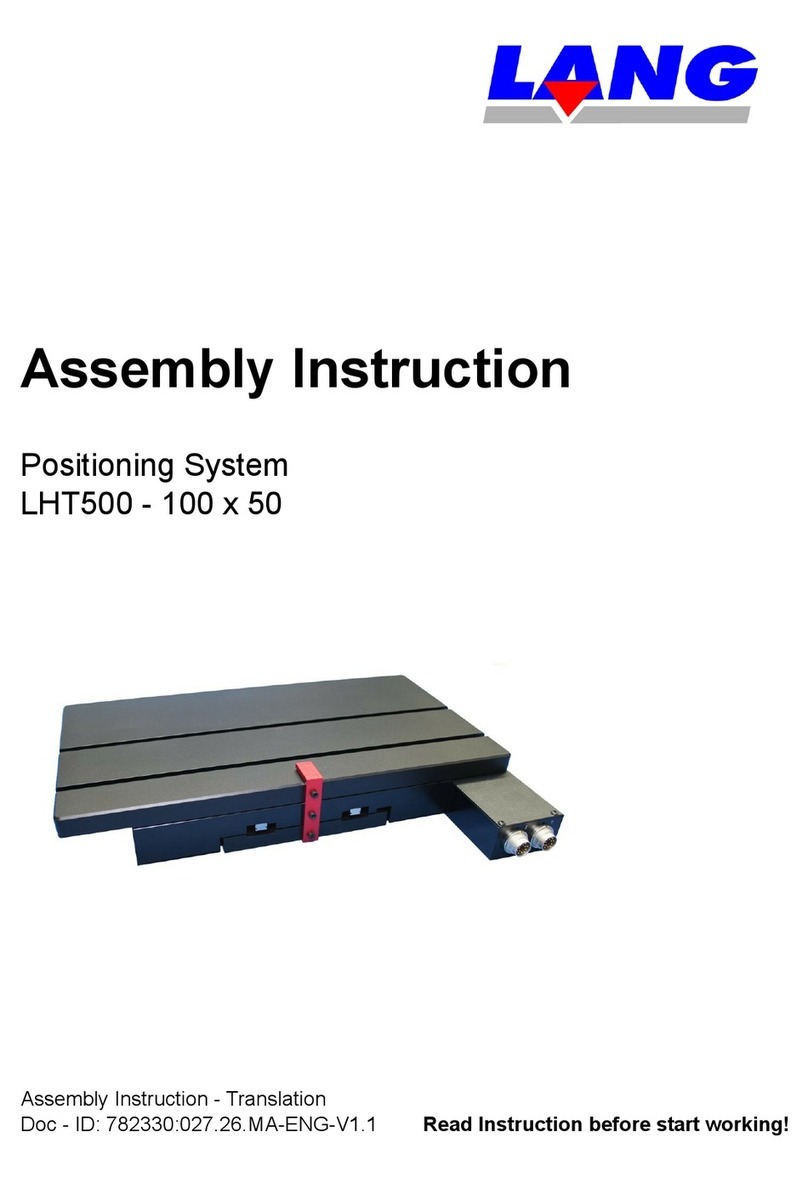IP80-TFI03GB-B
Installation and Maintenance Manual
IP8000-0##-# / IP8100-0##-#
Electropneumatic Positioner
1 Safety Instructions
•This manual contains essential information for the protection of users
and others from possible injury and/or equipment damage.
•Read this manual before using the product, to ensure correct handling,
and read the manuals of related apparatus before use.
•Keep this manual in a safe place for future reference.
•These instructions indicate the level of potential hazard by label of
"DANGER", "WARNING" or "CAUTION", followed by important safety
information which must be carefully followed.
•To ensure safety of personnel and equipment the safety instructions in
this manual and the product catalogue must be observed, along with
other relevant safety practices.
WARNING
• The compatibility of pneumatic equipment is the responsibility of
the person who designs the pneumatic system or decides its
specifications.
Since the products specified here can be used in various operating
conditions, their compatibility with the specific pneumatic system must
be based on specifications or after analysis and/or tests to meet
specific requirements.
• Only trained personnel should operate pneumatically operated
machinery and equipment.
•Compressed air can be dangerous if an operator is unfamiliar with it.
Assembly, handling or repair of pneumatic systems should be
performed by trained and experienced personnel.
• Do not service machinery/equipment or attempt to remove
components until safety is confirmed.
1) Inspection and maintenance of machinery/equipment should only
be performed after confirmation of safe locked-out control positions.
2) When equipment is to be removed, confirm the safety process as
mentioned above. Switch off air and electrical supplies and exhaust
all residual compressed air in the system.
3) Before machinery/equipment is re-started, ensure all safety
measures to prevent sudden movement of cylinders etc.
(Supply air into the system gradually to create back pressure, i.e.
incorporate a soft-start valve).
• Do not use this product outside of the specifications.
Contact SMC if it is to be used in any of the following conditions:
1) Conditions and environments beyond the given specifications, or if
the product is to be used outdoors.
2) Installations in conjunction with atomic energy, railway,
air navigation, vehicles, medical equipment, food and beverage,
recreation equipment, emergency stop circuits, press applications,
or safety equipment.
3) An application which has the possibility of having negative effects on
people, property, or animals, requiring special safety analysis.
CAUTION
•Ensure that the air supply system is filtered to 5 microns..
2 Specifications
Protect the unit from impact and dropping during transfer and when
mounted. It may cause failure of the unit.
• Do not use the unit in places with high humidity & temperature. It may
cause malfunctions.
• Do not use this positioner outside of the range of it's specifications as this
can cause failure.
*1 : 1/2 split range is possible with the standard type (by adjusting the span)
*2 : The stroke is adjustable in 0~60° and 0~100°.
*3 : Standard air (JIS B0120): temp.20°C, absolute press. 760mmHg,
ratio humidity 65%.
2.1 How to Order
3 Installation
WARNING
• Do not install unless the safety instructions have been read and
understood.
• Since zero-point varies depending on the mounting position, the zero point
should be adjusted after installation.
• Avoid hitting the product with metallic objects!
• Avoid using this product in non-explosive environments which can become
explosive due to air leakage!
3.1 Environment
WARNING
• Do not use in an environment where the product is directly exposed to
corrosive gases, chemicals, salt water, water or steam.
• Do not mount the product in a location where it will be subject to strong
vibrations and/or shock.
• Do not mount the product in a location where it is exposed to radiant heat.
• Allow sufficient space for maintenance and adjustment around the product
when mounted.
3.2 Piping
CAUTION
• Before piping make sure to clean away all chips, cutting oil, dust etc.
• When installing piping or fitting into a port, ensure that sealant material
does not enter the port inside. When using seal tape, leave 1.5 to 2 threads
exposed on the end of the pipe/fitting.
3.3 Lubrication
CAUTION
• The positioner has a fixed orifice and nozzle, which contain fine paths in
them. Use filtered, dehydrated air and avoid the use of lubricators as this
may cause malfunction of the positioner. Ensure that the air supply system
is filtered to 5 micron. Setting
3.4 Handling
CAUTION
• Avoid giving impact to the body and torque motor of the positioner, and
giving excessive force to the armature because this leads to failure. Handle
with care during transport and operation.
• If you leave the positioner at the operation site for a long time without using
it, put the cover on it so that rain water does not enter the positioner. If the
atmosphere is of high temperature or humidity, take measures to avoid
condensation inside. The condensation control measures must be taken
thoroughly for export shipment.
• Avoid setting the positioner near magnetic fields because the
characteristics are effected.
4 Mounting
4.1 Type IP8000
4.1.1 Example of attaching to actuator
The type IP8000 positioner is compatible with Type IP6000 and IP600 in the
attaching pitch. If you are using IP600 and IP6000 already, the bracket for
these positioner can be used to attach IP8000 to the actuator. 4.2.2 Connection with feedback shaft
4 Mounting (Continued)
4.1.2 Connection with external feedback lever
4.2 Type IP8100
4.2.1 Example of attaching to actuator
The type IP8000 positioner is compatible with type IP610 and IP6100 in
the attaching pitch. If you are using IP610 or IP6100 already, the bracket
can be used to attach IP8000 to the actuator. If you change from IP6100
to IP8100 and select accessory H (with external scale plate), fork lever
type fitting needs to be adjusted at lower position.
Type IP8000 IP8100
Lever type lever Rotary type cam
Item Single action Double action Single action Double action
Input current 4~20mADC (Standard)*1
Input resistance 235 ±15Ω
Supply air pressure 0.14~0.7MPa
Standard stroke 10 ~ 85mm (External
lever allowable
runout angle 10°~ 30°)
Sensitivity Within 0.1%F S Within 0.5%F S
Linearity Within ± 1%F S Within ± 2%F S
Hysteresis Within 0.75%F S Within 1%F S
Repeatability Within ± 0.5%F S
Thermal coefficient Within 0.1%F S/°C
Output flow rate 80 I/min (ANR) or more (SUP=0.14MPa)*3
Air consumption Within 5 I/min (ANR) (SUP=0.14MPa)
Ambient and using
fluid temperature
Air connection port Rc1/4 (FEMALE)
Electric wiring
connection port
Material Aluminium diecast for the body
Mass Approx. 2.6kg with terminal box
(Approx. 2.4kg without terminal box)
Classification of
degree of protection
60°~ 100°*2
-20°C ~ 80°C
JISF8007 IP65 (conform to IEC pub.529)
G1/2 (FEMALE)
I P 8 00 - 0 - - Q
TYPE
0 LEVER TYPE
1 ROTARY TYPE
PRESSURE GAUGE
(SUP, OUT1)
0 None
1 0.2 MPa (R1/8)
2 0.3 MPa (R1/8)
3 1.0 MPa (R1/8)
CONSTRUCTION
0 NO TERMINAL BOX
1 WITH TERMINAL BOX
EMC CERTIFIED
NOTE: WHEN MORE THAN 2 ACCESSORIES
ARE REQUIRED THE SYMBOL SHOULD BE
STATED IN ALPHABETICAL ORDER
ACCESSORIES
NIL NO ACCESSORIES
(WITH STANDARD LEVER)
A WITH PILOT VALVE ADDED DIA. 0.7mm
ORIFICE FOR RESTRICTING OUTPUT.
B WITH PILOT VALVE ADDED DIA. 1.0mm
ORIFICE FOR RESTRICTING OUTPUT.
C FORK LEVER ASSEMBLY, TYPE M
(P368010-24)
D FORK LEVER ASSEMBLY, TYPE S
(P368010-25)
E WITH LEVER FEEDBACK UNIT FOR
STROKE 35 ~ 100mm,
(WITHOUT STANDARD LEVER)
F WITH LEVER FEEDBACK UNIT FOR
STROKE 50 ~ 140mm,
(WITHOUT STANDARD LEVER)
G WITH GAIN SUPPRESSION SPRING (A).
(WITHOUT STANDARD GAIN
SUPPRESSION SPRING)
H WITH EXTERNAL SCALE PLATE UNIT
J WITH OPENING CURRENT OUTPUT
(4-20mA DC)
Positioner Bracket
Bracket
Positioner Positioner
Bracket
shape
Example
Bracket
shape
Example
Fig.1 Example of
directly attaching to
diaphragm valve
Directly attach using the
screw hole at the side of
the positioner and the
screw hole at the yoke side
of the diaphragm valve.
Fig.2 Example of attaching
using the L-shape bracket
Attach by using screw
hole at the side of the
positioner and the screw
hole at the front mount of
diaphragm valve.
Fig.3 Example of attaching
using front bracket
Attach by using screw
hole at the back of the
positioner and the screw
hole at the front mount of
diaphragm valve.
Fig.7 Example of attaching using
the positioner back screw
Attaching using the screw hole at
the positioner back and the screw
hole at the actuator top.
Fig.6 Example of attaching using
the positioner side screw
Attaching using the screw hole of a
side of the positioner and the screw
hole at the actuator top.
(1) Attach to the position that the
valve stem and lever form the
right angle when the input
signal is 50% (distribute
evenly with 50% input signal
set as the reference).
(2) Attach to the position of the
runout angle is within the
range of 10° to 30°.
(3) To move the valve stem
downward at the time of input
current increase (normal
actuation), attach to the
position at which the
tightening spring comes to the
upper side of the connecting
metal, as shown in Fig 5.
T
o move the valve stem
upward (reverse actuation),
turn-over the feedback lever
and attach to the position at
which the tightening spring
comes to the lower side of
connecting metal.
Tighening spring
Right angle
Input 0% (or 100%) position current
Input 100% (or 0%) position current
Input 50% position current
Connecting metal
Valve stem
Positioner body
Fedd back
lever
(The stem moves down as the input increases)
Stem direction
Stem direction
Turn over the feed
back lever
Fig.4 Attaching the feed back lever
OUT1 OUT2
Bracket shape
example
Bracket shape
example
OUT1 OUT2
Fig.5 Use position for feedback lever
(1) Attach to the position at
which the positioner feed
back shaft and the rotary
actuator main shaft are
almost concentric (range in
which the spring pin of feed
back shaft edge enters the
hole of fork lever assembly
shaft edge).
(2) If the seration joint type for
IP610 is made in a special
specification, it can be used
for this connection.
Fork lever assembly
(P368010-36)
Positionery body
Fork pin unit
(P368010-23)
M8 x 1.25
Actuator main shaft
Spring pin
Fig.8 Attaching the feed back lever
DANGER In extreme conditions, there is a possibility of
serious injury or loss of life.
WARNING If instructions are not followed there is a possibility
of serious injury or loss of life.
CAUTION If instructions are not followed there is a possibility
of injury or equipment damage.
